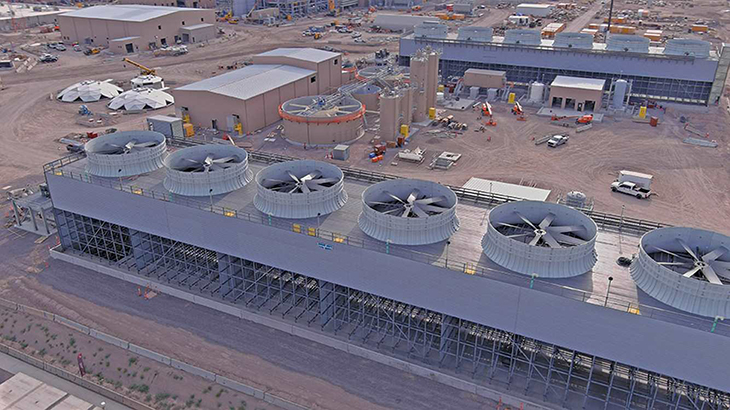

A significant chapter in America’s energy story is unfolding in the heart of Utah, where a coal-fired power plant that has supplied electricity to multiple states for decades is on the brink of a groundbreaking transformation. As the push for cleaner, more sustainable energy intensifies nationwide, billions of dollars are being funneled into modernizing this aging facility — and its future lies in hydrogen.
The Intermountain Power Project (IPP), located in central Utah, has been a dependable energy provider for over 40 years, lighting homes and powering industries in six western states. But as the world transitions toward greener energy sources and cuts back on carbon emissions, the plant has reached a crossroads. Its contracts to supply electricity are nearing expiration, presenting a timely opportunity for reinvention.
What makes this location particularly ideal for such an ambitious transformation is an unusual geologic feature hidden beneath it.
“Through a stroke of good fortune, the original Intermountain Power Project was constructed directly above a geologic salt dome that is uncommon in this part of the country,” explains IPA spokesman John Ward. “That salt dome presented a unique opportunity to develop long-term, large-scale energy storage in addition to the new generating capacity.”
These underground salt caverns — vast, naturally occurring voids within thick layers of salt — are especially suited for storing gases like hydrogen. The ability to store massive volumes of hydrogen on-site not only makes the plant’s conversion feasible but positions it as a critical energy hub for the future.
The momentum for this transition began back in 2015 when the Intermountain Power Agency (IPA) — a collective of 23 municipalities owning the plant and its transmission infrastructure — initiated a feasibility study. They explored replacing the coal-burning units with cutting-edge Mitsubishi gas turbines capable of operating on a blend of natural gas and hydrogen.
Seven years of planning, engineering, and negotiating followed before construction officially began. The innovative plan involves generating hydrogen through electrolysis, a process that splits water into hydrogen and oxygen using electricity. Significantly, this electricity will come from renewable sources like solar and wind, meaning the hydrogen produced will be entirely emissions-free.
Initially, the gas turbines will burn a mixture containing 30% hydrogen, with the rest from natural gas. This blend is expected to increase over time as hydrogen production technology scales up and becomes more affordable.
Though renewable energy sources like solar and wind are crucial to a sustainable future, they come with storage and intermittency challenges. Energy must be used as it’s generated or stored immediately, typically in costly and limited-capacity batteries. Hydrogen offers a solution to this dilemma. Unlike electricity, hydrogen can be stored in large quantities and used as needed.
“Hydrogen gas is already in a storage form, meaning more can be burned or less depending on a community’s needs, compared to something like solar which has to power something as soon as it’s generated, be stored in a battery, or be lost,” the article explains. This makes hydrogen a valuable tool for balancing grid demand and ensuring reliable power delivery, especially when renewable sources are variable.
The scale of this undertaking is immense. Around $1.7 billion has been earmarked for new generating equipment, while an additional $2.7 billion will be invested to upgrade IPA’s Southern Transmission System, which transports power to customers throughout the region.
Three major contractors have been brought in to handle the complex renovations, including The Industrial Co. (TIC).
According to TIC project manager Petar Willhite in Engineering News Record, “2,000 employees have put more than 5 million labor hours combined into the project so far.” This considerable workforce is a testament to the scope and importance of the effort, blending old infrastructure with new technology.
A particularly ambitious component involves drilling access shafts into two vast underground caverns. These will eventually store a hydrogen-natural gas blend equivalent to 4.5 million barrels of oil in liquid form, offering storage not just for the plant itself but potentially for other energy partners looking to transition toward hydrogen.
To support this effort, the U.S. Department of Energy is providing a $504 million loan guarantee for the Advanced Clean Energy Storage (ACES) Delta project, which will harness the underground salt caverns for large-scale hydrogen storage. Designed by Mitsubishi Power and other collaborators, the system will initially convert over 220 megawatts of renewable energy into 100 metric tons of green hydrogen per day.
This project stands to be one of the largest renewable hydrogen energy storage systems in the world. By storing hydrogen generated from surplus renewable electricity, it ensures excess clean power isn’t wasted but reserved for times of high demand or low renewable output.
Once operational, the renovated plant is projected to reduce its operating emissions by a striking 75%, with expectations for further improvements as hydrogen technology evolves. “If better ways of synthesizing hydrogen gas at scale can be achieved in the future, that number will only climb,” the article notes.
Not only will this modernization extend the plant’s operational life and reduce its environmental footprint, but it will also set a precedent for how aging fossil-fuel infrastructure can be reimagined for a carbon-free energy future.
The transformation of the Intermountain Power Project represents a bold experiment in blending legacy energy infrastructure with cutting-edge clean technology. By taking advantage of natural geologic features, leveraging significant public and private investment, and uniting a skilled labor force, the project demonstrates a scalable model for other coal plants across the U.S. and beyond.
As hydrogen energy’s role in the global energy mix grows, projects like this not only deliver cleaner power but also fortify the resilience of regional grids, create thousands of jobs, and unlock the potential of renewable resources. The story of this Utah power plant’s reinvention is proof that with vision, investment, and innovation, even the most traditional facilities can find new life in a green-powered world.
What are your thoughts? Please comment below and share this news!
True Activist / Report a typo






